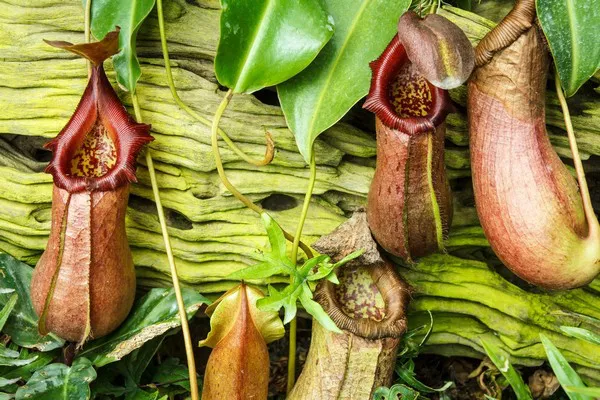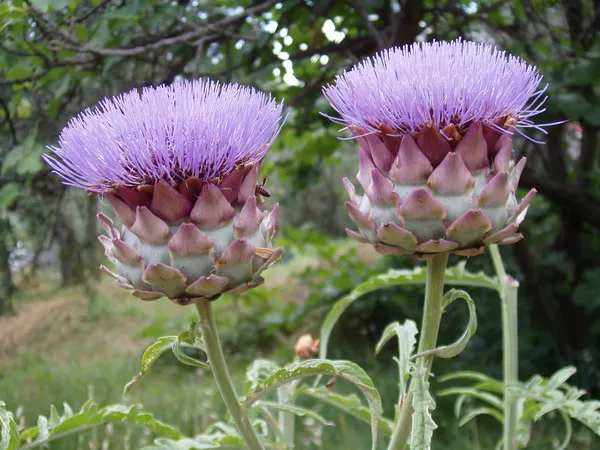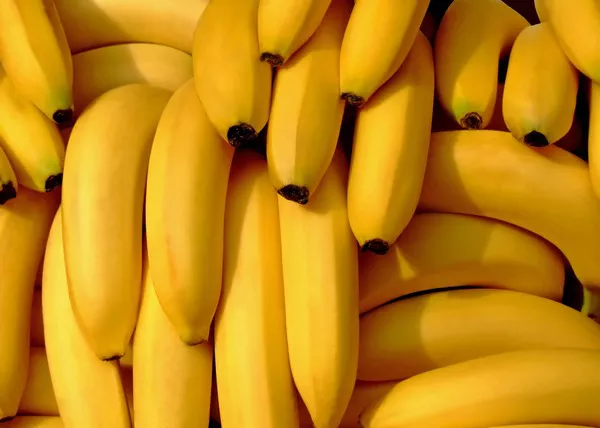In the botanical realm, where serenity and beauty often prevail, there exists a group of plants that defy expectations – the carnivorous plants. These remarkable specimens have evolved beyond traditional photosynthesis, developing ingenious adaptations to supplement their nutrient intake. As we embark on a journey into the fascinating world of deadly carnivorous plants, we unveil their lethal mechanisms, diverse habitats, and the intricate ways they capture and digest prey.
10 Deadliest Carnivorous Plants
1. Venus Flytrap (Dionaea muscipula):
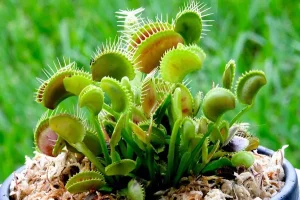
No discussion of carnivorous plants is complete without the iconic Venus flytrap. Endemic to the wetlands of the Carolinas in the United States, this captivating plant has earned its reputation as a botanical predator.
Mechanism of Capture: The Venus flytrap employs a unique snap trap mechanism to capture unsuspecting prey. Specialized leaves bear trigger-sensitive hairs, and when two or more are touched within a certain time frame, the hinged lobes of the leaf snap shut, entrapping insects. Digestive enzymes are then secreted to break down the prey and absorb essential nutrients.
Habitat and Conservation: Venus flytraps thrive in nutrient-poor soils, necessitating their carnivorous habits for survival. Despite their popularity, these plants face threats from habitat destruction and illegal poaching. Conservation efforts focus on preserving their native habitats and educating the public about responsible cultivation.
2. Pitcher Plants (Various Genera):
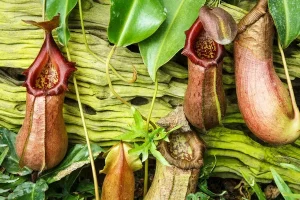
Pitcher plants encompass a diverse group with variations found on almost every continent. From the North American pitcher plant (Sarracenia) to the tropical Nepenthes of Southeast Asia, these plants share a common method of prey capture – the pitfall trap.
Unique Adaptations: The leaves of pitcher plants are modified into pitcher-shaped structures that collect rainwater. Insects, attracted by nectar and vivid colors, slip into the pitcher, where downward-pointing hairs prevent escape. Digestive fluids within the pitcher break down the prey into nutrients that the plant absorbs.
Biodiversity Hotspots: Pitcher plants are often found in nutrient-poor environments, including bogs and heathlands. Their incredible diversity and adaptation to different climates contribute to their role as biodiversity hotspots, supporting a range of insects and other arthropods.
3. Sundew (Drosera spp.):
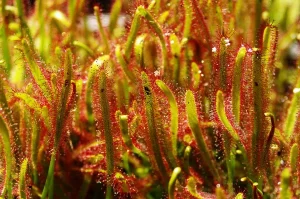
Sundews, belonging to the genus Drosera, are distributed across every continent except Antarctica. What sets them apart is their reliance on a sticky, glandular secretion to entrap and digest their prey.
Glandular Tentacles: Sundew leaves are adorned with glandular tentacles, each topped with a droplet of mucilage. Insects attracted by the plant’s glistening appearance become ensnared in the sticky substance. The tentacles then slowly curl over the prey, releasing digestive enzymes to break it down.
Adaptations to Nutrient-Poor Soils: Sundews are often found in habitats with poor soil quality, such as peat bogs and sandy heathlands. Their carnivorous habits provide a crucial nutrient supplement, allowing them to thrive in environments where traditional nutrient sources are lacking.
4. Cobra Plant (Darlingtonia californica):
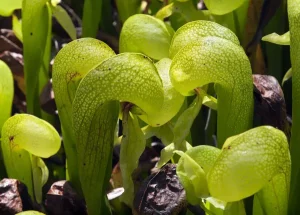
Native to Northern California and Oregon in the United States, the cobra plant, or Darlingtonia californica, is a visually striking carnivorous species. Its tubular leaves, resembling a cobra poised to strike, house a deadly pitfall trap.
Hooded Leaves: The cobra plant’s leaves feature a hooded structure with an opening that lures insects inside. Once within, downward-pointing hairs prevent escape, and the prey succumbs to digestive enzymes. The cobra-like appearance serves both a functional and aesthetic purpose.
Habitat and Conservation Challenges: Cobra plants prefer wet, boggy habitats, making them susceptible to habitat destruction and disturbance. Conservation efforts involve preserving their native habitats and addressing the impacts of climate change on these delicate ecosystems.
5. Waterwheel Plant (Aldrovanda vesiculosa):
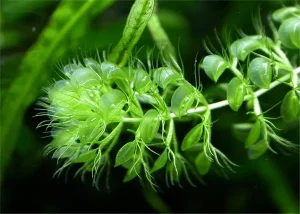
For a carnivorous plant, the waterwheel plant is a truly aquatic marvel. Found in nutrient-poor freshwater environments across Europe, Asia, Africa, and Australia, this submerged predator employs a rapid snap-trap mechanism.
Underwater Snap Trap: The waterwheel plant’s whorls of slender, toothed leaves float on the water’s surface. Tiny traps at the leaf nodes snap shut with remarkable speed, capturing aquatic invertebrates. The plant then secretes enzymes to break down the prey.
Conservation Status: While not extensively studied, the waterwheel plant faces threats from habitat loss and water pollution. Conservation efforts involve monitoring populations, protecting freshwater habitats, and raising awareness about the importance of preserving these unique aquatic carnivores.
6. Purple Pitcher Plant (Sarracenia purpurea):
Thriving in cold climates such as those of North America, the purple pitcher plant stands out as a carnivorous species adapted to withstand harsh winters.
Pitchers for Prey Capture: Similar to other pitcher plants, Sarracenia purpurea features modified leaves forming pitcher-like structures. Insects are lured by the plant’s vibrant colors and sweet nectar, only to find themselves trapped inside the pitcher. The plant extracts nutrients from the decomposing prey.
Adaptations to Cold Environments: This species has unique adaptations, such as a waxy coating on its leaves, enabling it to capture and digest prey even in colder temperatures. The purple pitcher plant’s ability to thrive in nutrient-poor soils contributes to its success in cold climates.
7. Butterwort (Pinguicula spp.):
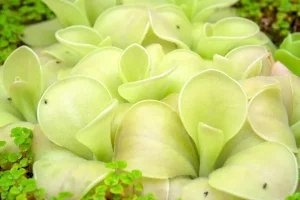
Butterworts, members of the Pinguicula genus, are distributed globally, with species found on every continent except Antarctica. These carnivorous plants exhibit a rosette of leaves covered in glandular hairs.
Sticky Glands: The leaves of butterworts are adorned with sticky glands that produce a mucilaginous substance. Insects landing on the leaves become trapped in the sticky secretion, initiating the digestive process.
Adaptation to Nutrient-Poor Habitats: Butterworts are often found in nutrient-poor soils, including rocky outcrops and alpine meadows. Their ability to extract essential nutrients from captured prey allows them to thrive in environments where traditional nutrient sources are limited.
8. Brocchinia reducta:
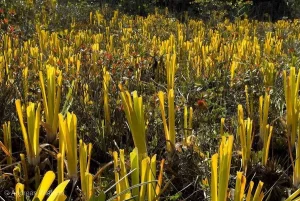
Among the bromeliads of South America, Brocchinia reducta stands out as a carnivorous species. Unlike its relatives, this bromeliad has adapted to nutrient-poor soils by evolving carnivorous habits.
Cup-Like Structure: Brocchinia reducta features a cup-like structure formed by tightly packed leaves. This structure collects rainwater, attracting insects seeking water. Once inside, the prey encounters digestive enzymes that facilitate nutrient absorption.
Unique Bromeliad Adaptation: While most bromeliads are epiphytic and absorb nutrients from the air and rain, Brocchinia reducta has evolved a different strategy. Its carnivorous adaptation sets it apart, allowing it to thrive in regions where nutrient availability is a challenge.
9. Genlisea spp.:
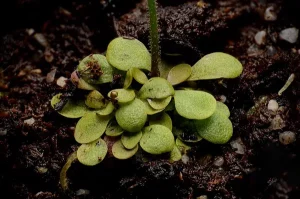
Genlisea, also known as corkscrew plants, are a genus of carnivorous plants with a unique subterranean lifestyle. Found in nutrient-poor soils across Africa, South America, and North America, these plants exhibit specialized trapping mechanisms.
Underground Traps: Genlisea species develop tubular, underground traps that capture microscopic organisms. The traps, often corkscrew-shaped, create a labyrinthine structure where prey becomes entangled. Digestive enzymes released in the trap break down the captured organisms.
Adaptation to Nutrient-Poor Environments: The subterranean lifestyle of Genlisea is an adaptation to environments with limited nutrient availability. By capturing and digesting small prey, these plants extract essential nutrients to supplement their diet.
10. Roridula spp.:

Roridula, native to South Africa, represents a unique case of mutualistic carnivory. While it captures insects, it relies on a symbiotic relationship with predatory insects for nutrient absorption.
Sticky Glandular Hairs: Roridula plants have sticky glandular hairs on their leaves, similar to carnivorous plants. However, they lack digestive enzymes. Insects trapped on the leaves attract predatory bugs that feed on them.
Symbiotic Relationship: Roridula plants and their associated bugs share a mutualistic relationship. The bugs benefit from a reliable food source, while the plant gains nutrients indirectly through bug excrement.
Closing Thoughts
As we delve into the captivating world of deadly carnivorous plants, it becomes evident that these botanical predators have mastered the art of adaptation. From the iconic snap traps of the Venus flytrap to the subterranean hunting strategy of Genlisea, each species showcases a unique approach to supplementing nutrient intake. While their lethal mechanisms may evoke a sense of danger, these plants remind us of the intricate balance in nature, where survival often hinges on ingenious adaptations to challenging environments.
You Might Be Interested In:

